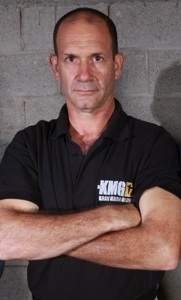Armed Attacker Seminar
Saturday, 16th February 2013
Lance Manley- P1
Saturday 16th of February was the Armed Attacker seminar. UK Krav is not predominantly based on guns, due to the lack of them in general street crime. As a result we focus mainly on knife attacks in classes. After all, the average Chav mugger has free and easy access to his mother’s cutlery drawer, but finds it harder to get hold of something that fires bullets.
Knowing this seminar had sold out a week or two in advance (with Bartosz booking “the other half of the sports hall” to allow for extra people) I was keen to attend and try a different side of Krav Maga.
First of all, it was great to see people from other clubs. I chatted to a couple of guys who had come from the south of England, one from London and the other Bristol. I also got to meet members of the other Krav Maga Midlands groups, which was cool as we rarely interact apart from the occasional social event or when people borrow another group, either due to missing their regular session or taking Option 2 on the payments scheme (the right to attend any and all classes that KMG Midlands holds in a week).
Have to say that the warm-up brought the kid out in me. So much fun chasing some bloke around a huge sports hall along with 50 other people, playing Tig. After that brief burst of cardio, we cracked straight on with knife attacks.
This was something we’d covered in classes but it was good as it put some shine on the rust and meant we slid straight into it. The much larger space to train in was appreciated. While Krav teaches you to fight and defend in ANY space, be it confined or vast, it’s good to know you won’t be smacking the back of your head into the pair training behind you (although I’ve no doubt that would be blamed on me neglecting to scan after attacking!)
After that we moved to 4 feet-long sticks. Thankfully the wooden sticks we used had foam sheathing but still gave a whack if you got them across the head or forearms. This was my favourite part of the seminar, as there is something immensely satisfying about taking a big stick off someone. My partner was annoyed that I wouldn’t let the stick go unless he actually made me and mimed kicking my knee cap, saying “if I kicked you there, you’d let it go! I replied “yes, but you’re NOT kicking me there. Adapt!”
The best one of this whole section of training was the move that meant you forced your assailant’s arm up behind his back by twisting the stick, and put him on his knees. It is quite fiddly to do properly, but brutally effective if done right.
Finally we did gun disarm training. Personally I’m hesitant about this, as I believe you have to be VERY calm and sure of your abilities to even dream of thinking about taking a pistol off someone, let alone one being pointed in your face. However, Bartosz partially covered some of this, saying that some guy pointing a gun at you in the street is probably assuming you will do what he wants just because he is holding the pistol and won’t expect an unarmed “victim” to attack.
My other phobia on this one was the fact that the dummy guns were pistols with slides on the top. The disarm move taught us to grab the top of the gun and twist it away while stepping clear. I had evocative images of a real pistol in a real situation, accidentally firing in the struggle and breaking at least one of my fingers as the slide activated. Bartosz again covered this aspect, without anyone asking him, by saying that if you grip the top of the gun and the trigger is pulled, then the gun will jam and then have to be cleared and reloaded before it can be used.
Nicest part of the whole thing was finding out that if you take a pistol off someone properly, there’s a fair chance you will break their index finger as it’s going to be trapped in the guard.
Needless to say we threatened each other with fingers WELL clear of the dummy pistol’s trigger guard.
To round up, we had a pressure drill of one guy attacking a punch bag held by another student….while 3 or 4 guys came at him with a gun, a knife, a stick or a bottle (as the bottle moves are the same as for sticks or knives). I was in a group of 6 where me and a couple of other guys made a point of throwing the weapons away from us once we got them off the attacker. Made me smile when one or two people handed them back politely, then carried on punching the bag waiting for the next attack.
One thing I didn’t expect was the attendance certificates being awarded one at a time. We lined up against the wall and the names were called out with guys walking up and getting a round of applause from us, and a handshake off Bartosz and Russell. A nice touch and the perfect way to end this.
Really good day and the best fun I’ve had at Krav apart from my P1 grading. Just wish my forearms didn’t look like someone’s been at them with a steak tenderiser.
http://www.kravmaga-midlands.com/self-defence-classes/self-defence-krav-maga-classes-in-stratford-upon-avon





